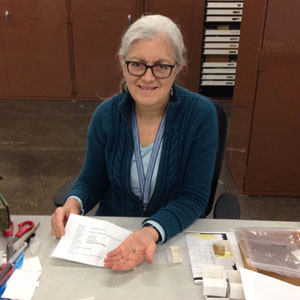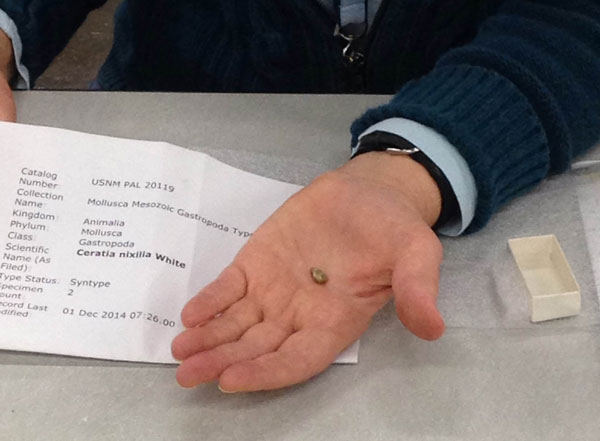
UCMP volunteers Kathy Zoehfeld and Don Pecko recently discovered a type specimen from the Smithsonian National Museum of Natural History among the hundreds of thousands of fossils in the former USGS Menlo Park collection. This type specimen, a tiny gastropod called Ceratia nixilia, was discovered in a drawer of fossils they were rehousing into new archival boxes. Don and Kathy not only noticed the less than a centimeter long gastropod, but brought it to my attention because they noticed the number written on the specimen. Noticing the green diamond also affixed to the fossil, we looked it up in the National Museum of Natural History database and discovered that it was listed as a holotype specimen.
Holotypes are the most important examples of a species, and the specimen that future researchers always return to determine whether their fossil is indeed the named one. Although some type specimens are lost due to disasters like the 1906 earthquake that destroyed much of the California Academy of Sciences collection, sometimes they are simply misplaced.
The U.S. Geological Survey had a close relationship with the National Museum of Natural History, and their offices housed in the same building for decades. Perhaps the specimen was accidentally transferred with the Pacific coast collections when the USGS Menlo Park office opened in the 1950s? Or perhaps it was sent out on loan to one of the paleontologists in the Menlo Park office and never returned?
Regardless of its journey, it eventually reached the UCMP, where my sharp-eyed volunteers signaled it out. The specimen will be returned to the National Museum of Natural History in Washington D.C. and again be made available for researchers. This discovery shows the true value of rehousing a collection because it requires handling every single specimen and often results in lost specimens being returned to their proper location.
We are grateful to the National Science Foundation for the funding to complete this worthwhile project. I am lucky to be working with volunteers as dedicated to returning every fossil to its proper place as I am.
